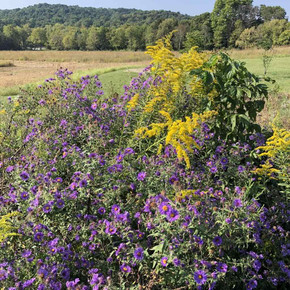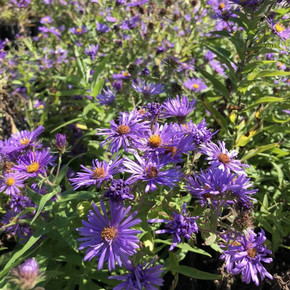
Aster cordifolius (Symphyotrichum) - HEART-LEAF ASTER (COMMON BLUE WOOD ASTER)
Very late-blooming native perennial with clouds of small pale blue flowers that are an important source of pollen and nectar for butterflies and bees at the end of the season. Upright plant with heart-shaped basal leaves. Blooms as the leaves of some trees turn yellow, creating a nice contrast. Each flower is only 1/2" in diameter.
This woodland Aster is tough and highly adaptable to soil, light and moisture conditions, though it prefers some shade and, for the best blooming, should get at least 3 hours of sun. Best in half shade or light shade gardens, for pollinator gardens, woodland edges and gardens, or for naturalization. Although this plant is sometimes considered somewhat weedy, it is great companion to other woodland (shade or half shade tolerant) plants.
Tolerates black walnuts and nearly full shade. Dead-heading will prevent seedlings.
Blooming Time: September - October
Size: 3' tall x 1-1.5' wide
USDA Zones: 3 to 9
Culture: half shade, dappled shade (adaptable to nearly full sun and nearly full shade); average soil, clay soil, gritty to loam
Moisture Needs: medium-moist, medium to medium-dry
Origin: native to the eastern half of the USA and Canada, plus the central US and British Columbia (USDA distribution map), where it can be found in light deciduous woods, thickets, on abandoned land, and along woodland edges
Deer/Rabbit Resistant: yes / yes
Attracts Butterflies or Pollinators: yes / yes, skippers and native bees; host plant for the Silvery Checkerspot Butterfly, Pearl Crescent Butterfly, and several species of moths
Attracts Hummingbirds: no
Pot Size: square 3.5" x 4" deep perennial pot
Plant Combinations: potential companions includeAconitum, Anemone virginiana, Anemone x hupehensis (Japanese Anemone and hybrids), Aster divaricatus, Chrysogonum virginicum, Eupatorium coelestinum, Heliopsis, Helianthus divaricatus, Geranium maculatum, G. macrorrhizum, Gillenia, Heuchera, Hosta (in half shade with average-moist soil), Phlox paniculata, Patrinia scabiosifolia, Rudbeckia triloba, Rudbeckia fulgida 'Goldsturm', Solidago caesia, Solidago flexicaulis, Vernonia, and grasses like Hakonechloa or Carex.
Picture Copyright: Sten, Commons Wikipedia

Aster cordifolius (Symphyotrichum) - HEART-LEAF ASTER (COMMON BLUE WOOD ASTER)
Very late-blooming native perennial with clouds of small pale blue flowers that are an important source of pollen and nectar for butterflies and bees at the end of the season. Upright plant with heart-shaped basal leaves. Blooms as the leaves of some trees turn yellow, creating a nice contrast. Each flower is only 1/2" in diameter.
This woodland Aster is tough and highly adaptable to soil, light and moisture conditions, though it prefers some shade and, for the best blooming, should get at least 3 hours of sun. Best in half shade or light shade gardens, for pollinator gardens, woodland edges and gardens, or for naturalization. Although this plant is sometimes considered somewhat weedy, it is great companion to other woodland (shade or half shade tolerant) plants.
Tolerates black walnuts and nearly full shade. Dead-heading will prevent seedlings.
Blooming Time: September - October
Size: 3' tall x 1-1.5' wide
USDA Zones: 3 to 9
Culture: half shade, dappled shade (adaptable to nearly full sun and nearly full shade); average soil, clay soil, gritty to loam
Moisture Needs: medium-moist, medium to medium-dry
Origin: native to the eastern half of the USA and Canada, plus the central US and British Columbia (USDA distribution map), where it can be found in light deciduous woods, thickets, on abandoned land, and along woodland edges
Deer/Rabbit Resistant: yes / yes
Attracts Butterflies or Pollinators: yes / yes, skippers and native bees; host plant for the Silvery Checkerspot Butterfly, Pearl Crescent Butterfly, and several species of moths
Attracts Hummingbirds: no
Pot Size: square 3.5" x 4" deep perennial pot
Plant Combinations: potential companions includeAconitum, Anemone virginiana, Anemone x hupehensis (Japanese Anemone and hybrids), Aster divaricatus, Chrysogonum virginicum, Eupatorium coelestinum, Heliopsis, Helianthus divaricatus, Geranium maculatum, G. macrorrhizum, Gillenia, Heuchera, Hosta (in half shade with average-moist soil), Phlox paniculata, Patrinia scabiosifolia, Rudbeckia triloba, Rudbeckia fulgida 'Goldsturm', Solidago caesia, Solidago flexicaulis, Vernonia, and grasses like Hakonechloa or Carex.
Picture Copyright: Sten, Commons Wikipedia
Customer Reviews
-
I bought 2 nice sized plants at great price
Both bloomed, I am very pleased, thanks
-
Carefully package, fast shipping! Plants look great.
Carefully package, fast shipping! Plants look great.







